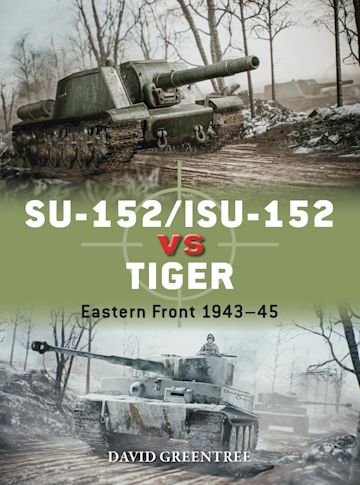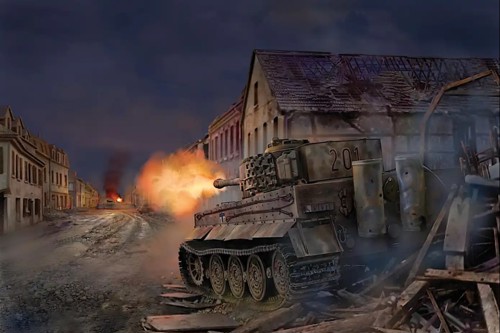
Factfile
German military leaders faced with the challenge of the size and technical proficiency of the Red Army sought the annihilation of the enemy and thought they had the weapon to achieve this with the Tiger. Two firms produced prototypes in 1942: Porsche and Henschel. The Army General Staff realized not enough Tigers could be produced to allocate one Tiger company per panzer battalion. The decision to concentrate them into independent heavy battalions was made; dispersing Tigers in penny packets to support other panzer units was not thought to be a good idea because maintenance resources needed to be centralized.
The first three battalions would be created in May 1942. On the Tiger’s first deployment a platoon of four got stuck in the mud near Lake Ladoga in September 1942. Then enemy rounds hit, destroying the barrel of one, immobilizing another. The engine of a third caught fire, creating a burning wreck the Soviets then captured. Despite the questioning of the Tiger programme, and the fact that factories could produce double the number of Pz IVs, the German leadership demanded an expansion of production.
Technical Specifications
- Earlier Tiger designs had a 650hp Maybach engine. From spring 1943 a 700hp HL 230 TRM P45 23l Maybach engine was installed.
- The range was 120km on roads and 85km on firm ground, using 348 litres of fuel.
- Two 200-litre fuel cells could be carried on the back deck for long road marches.
- British trials noted that the Tiger could manage 21.5mph (34.6km/hr) on roads and 15mph (24km/hr) off road when the engine was measured, providing 592hp.
- The suspension comprised torsion bars running the width of the hull.
- The bars connected to road wheel arms, each of which had three wheels, overlapping wheels from adjacent wheel arms, creating a pattern that spread the load of the Tiger onto the track.
- A smooth ride was provided by hydraulic shock absorbers fitted to the front and back road wheel arms.
- Early production models had wheels with rubber rims; these would be replaced by metal road wheels in January 1944.
- New tracks with cast cleats for extra traction in the snow would be introduced from October 1943.
- Ten spare track links and pins would be carried in a container at the back of the turret. Spare links would be carried on the lower front hull plate and later on fittings welded onto the side of the turret.
- To his right the commander had a manually operated wheel to rotate the turret, a single degree per two rotations. The commander decided whether to engage the target, and he was told to make rapid decisions based on good observation of the battlefield.
- The powered controls to operate the turret rotation had to be low geared because of the 120mm armour on the turret front, and thus they were slow, taking 60 seconds to rotate 360 degrees.
- A large spring housed in a cylinder on the left side of the turret compensated for the weight of the gun tube.
- The Tiger’s 8.8cm KwK L/56 used the 8.8cm Sprgr Patr HE round, the 8.8cm Pzgr Patr 39, plus small numbers of the 8.8cm Pzgr Patr 40 and Gr Patr 39 HI shaped charge. Two-thirds would be armour piercing.
- The life of the 8.8cm barrel was given as 6,000 rounds. The 8.8cm gun had a one-piece barrel in a thin jacket. Priming was electrical rather than percussion.
- A C/22 electrical primer took its power from the vehicle battery. The breech block slid vertically. Two hydraulic recoil mechanism cylinders were attached to the sides of the main gun tube, the recoil buffer on the right and the recuperator on the left.
- The co-axial MG 34 7.92mm machine gun in the gun mantlet was operated by a floor pedal and could be fired at from minus eight degrees to plus 15. A second MG 34, ball mounted and located on the right side of the hull, was capable of 15 degrees traverse left or right and elevation of minus seven to plus 20 degrees.
- The machine gun was fitted with a KZF 2 sighting telescope capable of 1.75 magnification. Some 4,500 rounds were initially supplied for the machine guns, 4,800 by February 1944. An MG 34 could be carried on the turret, also fitted to the command Tiger.
- The TZF was a binocular sight with 2.5 magnification. The commander had a turret position indicator. He operated a 10 SF 14Z stereo binocular sight and EM 34 range finder, increasing the range to 4,000m. A target 1,000m distant measuring 2.5m x 2m would be hit 100 per cent of the time, at 2,000m 87 per cent, and at 3,000m 53 per cent.
- A British test on a target moving at 15mph (24km/hr) at 1,500yd (1,370m) achieved 60 per cent success using lowspeed gun laying. High-speed traverse reduced accuracy.
- Elevation angle ranged from plus 16 to minus seven degrees. Ammunition was stowed using four racks of 16 rounds (50/50 mix of AP/HE), four racks of four rounds (AP) and two racks of six rounds (AP). The Tiger command tank would have 66 rounds.
- Tigers had a FuG 5 to communicate with other Tigers; the platoon commander also had a FuG Command Tigers had FuG 5 and either a FuG 7 to communicate with Army commanders or a FuG 8 to communicate with the Luftwaffe.
- They had the turret MG removed and the aperture was filled with a plug. The command Tigers had the FuG 5 in the turret and the antenna for the FuG 8 for communication with higher HQ attached to the hull. The FuG 8 could transmit at 30W and had a star antenna. The FuG 7 radio did not possess the star antenna.
- The Tiger had a circular escape hatch on the left rear of the turret and machine pistol port on the right rear. The turret roof armour increased from 26mm on September 1943 models to 45mm on later models from spring 1944.
- The commander’s cupola was modified to accommodate the thicker armour. Front turret armour set at 90 degrees was 97mm; turret side set at 90 degrees was 82mm, as was the turret rear and hull armour.
- Upper hull front armour set at 80 degrees was 102mm, lower hull front armour set at 70 degrees was 102mm; upper hull side armour set at 90 degrees was 82mm, lower hull side armour set at 90 degrees was 62mm. Glacis front armour set at 10 degrees was 62mm.

Pershing vs Tiger: Germany 1945
During the evening of 26 February 1945, Tiger I Nr. 201 of sPzAbt (FKL) 301 moved down Köln-Aachener Straße in Elsdorf to confront the approaching tanks of Task Force Welborn of the 3rd Armored Division. Around 2100hrs, an M4 tank was set ablaze, either by a Panzerfaust or German artillery fire. This fire silhouetted the turret of T26E3 “Fireball” that was partially hidden by a street barrier. The Tiger fired three shots in rapid succession from a range of about 100m. The first shot penetrated through the coaxial machine-gun opening in the gun mantlet, killing the Pershing's gunner and loader. The second 8.8cm round hit the muzzle brake of “Fireball,” jamming the barrel and causing the 90mm round to detonate prematurely in the tube. The third 8.8cm round glanced off the upper corner of the mantlet of “Fireball.” Moments later, Tiger I Nr. 201 became immobilized in the rubble of house No. 74 when it tried to reverse back down the street. The crew abandoned the Tiger I and it was recovered by US troops the following morning.
Artwork and Factfile from SU-152/ISU-152 vs Tiger: Eastern Front 1943–45 illustrated by Jim Laurier.
You can find out more about the Tiger tank in this blog post.

Comments
You must be logged in to comment on this post. Click here to log in.
Submit your comment